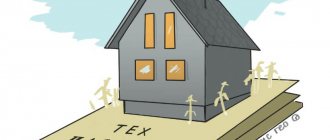Violation of installation technology and the use of low-quality or unsuitable building materials in almost 60% of cases causes the collapse of buildings. If, during the acceptance of a newly constructed facility, a detailed inspection of structures and utilities is carried out and serious inconsistencies are identified, then accidents with dire consequences can be avoided.
Subject matter experts are invited to conduct the examination. They draw up a report on identified defects in construction if damage was discovered during work. The subject of the research is enclosing and load-bearing elements (walls, roofing, soils and foundations, foundations, columns, floors), water supply, heating, sewerage, ventilation systems and other engineering equipment. Engineers also pay attention to tightness, reliability, and quality of connections.
Evaluation of a newly constructed facility involves analysis according to the following parameters:
- compliance with urban planning, sanitary and other legislative requirements, GOSTs, SNiPs, methods;
- comparison of actual indicators with design solutions;
- examination of the quality of installation work;
- study of the characteristics of building materials and their compliance with design documentation.
If during the inspection experts discover defects and violations, the information is recorded in a technical report. This act is a mandatory document upon delivery of the constructed facility.
Defects appear not only due to non-compliance with urban planning norms and rules. They can be the result of exposure to external adverse factors - rain, snow, groundwater, careless or intensive use, mechanical and chemical agents. In addition, there is a time factor that contributes to the gradual moral and physical deterioration of the object.
Therefore, an examination in order to search for damage can be organized at other stages of operation - before reconstruction and major repairs, after the end of the standard service life of the facility, to justify the accident hazard of the structure, or as part of regular monitoring of the technical condition of the structure.
Why is a defective act needed?
During an inventory inspection or quality check of operating systems (equipment), an expert commission may identify defects.
The commission records its conclusions regarding the impossibility of eliminating these defects or the scope of necessary repairs in a special document generated based on the results of the inspection (verification) - a defect report. A missing or incorrectly drawn up defective act often becomes the reason for the tax inspectorate not to recognize the costs of repairing (writing off) OS (equipment) in tax accounting, which leads to additional taxes and penalties.
Explanations from experts, which you can view in ConsultantPlus, will help you correctly and fully document OS repairs and avoid claims from inspectors. Trial access to the system can be obtained for free.
Purpose of an act of elimination of defects in construction
Unscrupulous contractors come up with various tricks to save on materials and installation work. They may purchase low-quality bricks and connecting elements, neglecting the important stage of preparation for laying the foundation, erecting other enclosing and supporting structures, in order to bring the project completion date closer. It is sometimes possible to detect violations and inconsistencies only by professionals through a detailed examination and using modern equipment.
The act of eliminating defects in construction is aimed at solving the following problems:
- detect obvious and hidden damage;
- study the scale of the problem - how the identified defects affect the strength, reliability and safety of the structure;
- develop a list of measures that are necessary to eliminate damage and restore the facility to normal operating parameters;
- assess whether additional costs for eliminating defects are worthwhile. Sometimes it is easier and more profitable to dismantle a damaged building and build a new one from scratch;
- compile a list of persons responsible for identified violations in installation technology and detected damage.
The inspection report for defects in construction is used to substantiate and fill out related documentation. On its basis, a write-off of used materials, an estimate, a financial report and an order to carry out repair and restoration work are drawn up.
The experts’ task is not just to detect defects, but also to indicate how they can affect the operational characteristics of the building. For example, severe subsidence of the foundation often leads to the formation of cracks in load-bearing walls. If necessary, specialists additionally formulate a rational strategy for the restoration, strengthening and repair of the structure, and draw up an estimate.
Drawing up a defective act for writing off fixed assets (equipment): sample
A defective act for writing off OS (equipment) is generated and confirmed by a commission approved by order of the organization. The commission must include: the chairman of the commission appointed by order, the chief accountant, the employee responsible for the safety of the OS (equipment), and a specialist who understands the technical characteristics of the OS (equipment) being inspected. In the absence of the latter on the organization’s staff, third-party companies that carry out a technical assessment of the operating system (equipment) are invited to draw up a defect report.
The defective act for write-off of OS (equipment) specifies the following mandatory information:
- Title of the act.
- Date of formation and approval of the act.
- The name of the organization drawing up the act.
- Name and accession number of the object.
- Description of defects that are considered irreparable from the point of view of physical wear and tear or obsolescence.
- Technical parameters of detected defects and their units of measurement.
- Positions, surnames, initials and signatures of the commission members.
Find out about the nuances of filling out a defect report in the Typical Situation from ConsultantPlus. If you do not have access to the K+ system, get a trial online access for free.
A sample defect report for write-off of fixed assets (equipment) is available for download on our website.
IMPORTANT! A defect report refers to documents containing only a qualitative assessment of the technical condition of the OS (equipment) subject to write-off (repair), and cost indicators are not included in it.
For information on what primary accounting documents will be used to document the write-off of fixed assets (equipment), read the material “Documentary registration of write-off of fixed assets.”
How to draw up a defective statement
Draw up technical documentation on company letterhead and the form specified in the accounting policy. Prepare several copies - one each for the customer, technical supervision (if he was involved), the estimate developer and other parties.
Instructions on how to draw up a troubleshooting report for a customer for repair or construction work:
- Enter the name of the customer.
- Determine the object - its name, address, name of the structural element (building, premises).
- Enter the serial number and date.
- Title the documentation.
- Create a table. It describes the identified defects and the volume of required construction, and clarifies the details in the form of notes. Be sure to describe the planned work (point by point) and indicate the unit of measurement.
- List all committee members and leave space for their signatures.
- Give it to your manager for signature. The director of the state customer coordinates and approves the document: he puts his signature and date in a specially designated place - at the top before the act.
If you find an error in the calculations, correct it: carefully cross it out and indicate the correct value at the top signed by the person in charge. Or print out new copies of the act and sign them with the members of the commission and the head of the customer organization.
Drawing up a defect report for the repair of operating systems (equipment): sample
The unified form of a defect report for the repair of OS (equipment) was approved by Decree of the State Statistics Committee of Russia dated January 21, 2003 No. 7 and is called “Act on Identified Equipment Defects” (form OS-16).
In terms of its content, the presented document is not universal and is unacceptable for a number of defect recording situations. For example, this form is not suitable for reflecting defects in real estate. In such cases, organizations have the right to draw up and approve their own form of a defect report indicating the required information (clauses 2, 4, article 9 of the Law “On Accounting” dated December 6, 2011 No. 402-FZ).
The basic rules for independently drawing up a defect report for the repair of operating systems (equipment) are similar to the rules for drawing up a defect report for their write-off, set out in the previous section. At the same time, the mandatory information (clause 5 of the list we provided above) provides a description of the defects that must be eliminated by a third-party contractor or on our own.
A sample of a defect report for the repair of fixed assets (equipment) can be found on our website.
Who draws up an inspection report for defects in construction?
A specialist from an expert organization must impartially assess the quality of installation and repair work, perform the necessary measurements and tests, and provide a report on the work done and the results obtained.
An act of inspection of defects in construction will have legal force if it is drawn up in accordance with the established rules. A commission is appointed to conduct the assessment. It includes a representative of the construction company, the customer and an independent expert. The parties must agree on the composition of the commission before the inspection begins.
Typical and recommended forms of a defect report
Download the recommended forms of defective reports for write-off (repair) of OS (equipment) on our website:
- Defective report for repair of fixed assets (equipment)
- Defective act on write-off of fixed assets (equipment)
A standard form of form No. OS-16 is available for download in the article “Unified form No. OS-16 - form and sample” .
Design rules
We'll tell you how working documentation is drawn up for current repairs.
Agreement
A contract is concluded with a construction company or directly with the contractor allocated for the work. The customer can be either a management company or the owner of the property. Read more about who draws up the plan and carries out routine home repairs here.
Before concluding a contract, the customer has the right to familiarize himself with information about the upcoming progress of repairs. The Contractor, in turn, must provide the following information:
- price of services;
- Payment Methods;
- types and quality of work;
- information about the contractor (experience, qualifications, etc.).
In the event of a discrepancy between the order and the work performed or a violation of the contract, claims are brought against the contractor. If necessary, proceedings in court also take place with him. Therefore, data about it is an important point.
REFERENCE! According to Art. 503-505 of the Civil Code of the Russian Federation, if the terms of the contract are violated by the contractor, the latter undertakes to carry out repair or correction work at its own expense or pay the customer for material damage. The customer's responsibilities are specified in the agreement.
Now you know about the execution of a contract for the renovation of the premises.
Defective statement
This is a document that explains the company's costs for performing work. Compiling a statement is a labor-intensive process. For this purpose, a special commission is formed whose task is to check the quality of the repair, compare it with the original order and identify possible defects. The commission includes:
- Accounting department employee;
- representative of the equipment department;
- contractor, or one of the contract workers.
Drawing up a statement has two main functions:
- cost control;
- tax report.
The latter should be understood as justification before the tax office, that is, what the company’s money was spent on for a certain period.
The structure of the defect sheet for the repair of premises is a table containing information about the work performed , as well as about possible defects and inconsistencies identified during the commission.
There is no clear sample document. The defect sheet is the main document of the local estimate.
ATTENTION! The document must contain the signatures of all members of the commission and the manager of the construction company. Otherwise it is not valid.
Material write-off act
It is one of the reporting documents for the competent authorities. This document contains information about the building materials used, indicating the purpose of their use and the cost, which is debited from the company’s accounts.
To draw up an act for writing off materials, a commission is also formed, consisting of:
- person responsible for materials;
- chief accountant;
- authorized economist of the company.
Members of the commission certify the document with signatures.
Estimate
The most necessary document for repairs. In simple terms, this is a systematization of repair costs. The estimate for the renovation of the premises is drawn up if there is a budget , and implies a competent and rational calculation of the initial amount for the highest quality result. It includes:
- list of required materials and their cost;
- list of works and their cost;
- total transportation costs.
During planned repairs, the construction company accountant is responsible for drawing up estimates. Before this, a thorough inspection of the object/premises being repaired is carried out in order to calculate the amount of work and materials.
If you are doing the repairs yourself, then you can create an estimate yourself in Excel, but be very careful to calculate everything correctly. If you doubt your abilities, you can order an estimate from a construction company for a fee. Please note that the service itself will not be included in the document.
Technical task
Compiled by the customer (company or owner) for the contractor. In the first case, the preparation is carried out by an accountant together with a competent representative of the housing and communal services. In the second, it is either the owner himself or an employee.
The technical specification represents a detailed description of the object to be repaired, indicating the required services and materials, as well as the budget available to the customer. The TOR should describe with maximum precision everything that is required of the workers - it is this document that they will be guided by during the work.
REFERENCE! You can attach a ready-made estimate to the TOR and hand over the package of documents to the contractor. It is also possible that, based on the technical specifications, the contractor draws up all other documents independently.
Production log
Issued to the owner by the management company after receiving permission to carry out repairs. But not every type of work requires journaling , but only for those specified in paragraphs. 2 and 3 of Appendix 1 of PPM No. 508, namely:
- strengthening load-bearing walls;
- changing the design of floors;
- works related to waterproofing.
According to paragraph 1 of Appendix 4 of PPM 508 as amended by 840, the production log indicates “the technological sequence, timing, quality of execution and conditions for the production of redevelopment work.”
If you are given a journal, then there is a person assigned to it who has permission to fill it out. All records are certified by his signature, as well as the signatures of the owner and contractor.
Project
Do you need a project? Yes, its presence is mandatory for major repairs, but for current repairs it is compiled at the request of the customer.
The project is a graphical representation of the object after all relevant work has been carried out. It should indicate:
- location and layout of rooms/premises;
- installation locations of main equipment;
- sockets, switches.
Both a general project and a detailed one for each room can be drawn up.
The design is carried out by a designer who can be offered to you by a construction company, or you can hire one yourself.
Plan
Combines a technical specification, a project and an estimate. This is a description of the entire repair process, the necessary work and services, taking into account their cost, and also provides for unexpected situations and a way out of them.
The plan for the ongoing repair of an apartment building is drawn up by the customer together with the contractor and an employee of the construction company.
Application for work
The document relates to scheduled repairs. Such a statement is drawn up by residents who require repairs to be carried out in their home.
You can write a claim to the management company if the planned repairs were not carried out.
The management company is obliged to carry out planned repairs of apartment buildings in accordance with Resolution of the Civil Code for Construction No. 170 dated September 27, 2003 . The fee for scheduled repairs is included in the cost of utilities. Therefore, if the application to the Criminal Code is ignored, you have the right to go to court.
What is included in the maintenance and ongoing repairs of housing, read here, and this article talks about the legislative acts regulating the work.
Nuances of filling
During the inspection of any construction site, the expert commission must check each structural element separately. When conducting research, they establish the compliance of the construction and installation work carried out with approved norms and state standards. If problems arose at an object that has already been put into operation, then experts determine the percentage of actual wear for each element.
Very often, the need to draw up a defect report arises among business entities who are preparing their offices or production workshops for routine or major repairs. In this case, an expert commission formed of highly qualified specialists helps to calculate the total amount of expenses that the enterprise will have to incur to eliminate all the shortcomings. After signing the defect report, specialists draw up an estimate that describes upcoming repairs and also indicates the materials needed for the work.
Additional documents
To justify the need for major or current repairs in utility companies, specialists draw up a defective statement. This document must be signed by the head of the housing office, and only after that can it be transferred to production. This form must contain the following information:
- street name and exact address of the apartment where renovation work is planned;
- the stages of work are listed;
- elements requiring restoration are indicated;
- all defects and deficiencies identified during inspection are described, etc.
Important! The defective statement is drawn up in free form. It is a primary accounting document used by public utilities. Based on the defective list, major, emergency and current repairs are carried out. It may be accompanied by photographic documents, as well as witness statements. Such a statement serves as the basis for drawing up an estimate.
Post Views: 4,180
Study the prices for repairs or contact a contractor to draw up an estimate
The expert dwelled in detail on the question of who prepares cost estimates for routine repairs of common property in the apartment building. It could be:
- contractor,
- accounting and economists of the educational institution,
- board of a homeowners association or cooperative.
It makes sense to contact a qualified estimating service if the company does not have specialist estimators or if the estimate prepared by the contractors does not suit you.
If you decide to make an estimate for current repairs yourself, first study the territorial unit prices in construction for various types of work (TER). Find out where to find them in the video.
How an HOA can correctly prepare an estimate of income and expenses: expert advice
What document is drawn up when a defect is discovered?
A defect report is a paper recording breakdowns, malfunctions and shortcomings in any equipment or object. Such a document is related to the primary documentation and is based on the commission’s conclusion.
It is the defective act that can be the basis for writing off the operating system or product, since it contains data regarding identified defects in the equipment, and the act also indicates the option for correcting them if the commission has determined that the equipment is subject to restoration.
Important: a defective act must be drawn up in accordance with all requirements, since its inaccurate formation often serves as a refusal by the tax service to recognize repair expenses, which will entail the accrual of additional taxes and fines.
The act does not contain the price of repair work or damage received; it is the basis for drawing up:
- Estimates for repairs;
- Report on the feasibility of repairs;
- An order to carry out repair work;
- Write-offs of worn-out objects. Here you will learn how to correctly draw up an order to write off fixed assets.
Important: the document must be generated if the equipment is under warranty or service.
You will learn how to correctly compose and edit a defective statement in this video:
Who draws up the act and when?
When equipment breaks down, a special commission is assembled to determine the circumstances and extent of the damage by order of the head of the organization, which is responsible for drawing up such documentation.
The document must be signed by all participants in the equipment inspection.
Requirements for the composition of the inspection commission
The expert commission for carrying out defect detection is appointed by the head of the organization (the owner of the asset) by order. The commission must include:
- Representatives of the organization that owns the asset: technical specialists, workers who directly use the inspected object and identified the defect, representatives of accounting and administration (the owner), quality control department employees and other employees if necessary.
- Representatives of interested parties: suppliers, buyers, contractors, transporters, manufacturers, specialists from repair organizations and other interested parties.
- Experts. It is advisable to involve third-party, independent specialists.
In the work of the commission, a material person is necessarily involved, in charge of the object being examined. The composition of the commission largely depends on the purpose of drawing up the DA and is individual in nature. If it is planned to file a claim in the future, then the participation of representatives of the defendants is mandatory. If the issue of a technical breakdown is being resolved, then often it is enough to involve specialists from your organization (without outside participation).
The absence of representatives of the interested party may lead to the recognition of the results of the commission's work as invalid.











